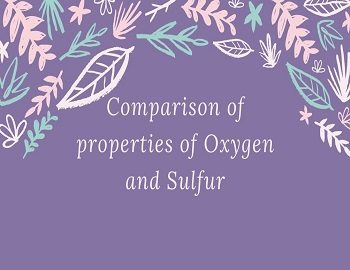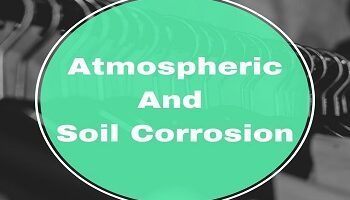Table of Contents
Comparison of properties of Oxygen and Sulfur:
Points of Similarity:
| Property | Oxygen | Sulfur |
|---|---|---|
| Electronic Configuration | 2, 6 | 2, 8, 6 |
| Nature | Highly electronegative in nature. | Highly electronegative in nature. |
| Oxidation State | Shows an oxidation state of -2. | It also shows an oxidation state of -2. |
| Allotropy | It shows the phenomenon of allotropy. | It also exhibits allotropy. |
| Action of metals | It forms the oxides- 2Mg + O2 —> 2MgO 2Cu + O2 —> 2CuO | It forms the sulfides- Cu + S —> CuS Fe + S —> FeS |
| Action of carbon | It reacts with carbon at high temperature to give CO2 or CO. 2C (excess) + O2 —> 2CO C + O2 (excess) —-> CO2 | It reacts with carbon at high temperature to give CS2. C + 2S —> CS2 |
| Action of hydrogen | It gives water. 2H2 + O2 —> 2H2O | It gives hydrogen sulfide. H2 + S —-> H2S |
| Non-metallic nature | Non-metal. | Non-metal. |
Points of Difference:
| Property | Oxygen | Sulfur |
|---|---|---|
| Physical State | Oxygen is a gas. | Sulfur is a solid. |
| Atomicity | It forms diatomic molecule as O2 and, thus, its atomicity is 2. | It forms molecules of type S8 and its atomicity is 8. |
| Combustion | It is non-combustible but is a supporter of combustion. | It is combustible and burns with a pale blue flame. |
| Formation of hydrides | Hydride of oxygen, H2O, is a liquid because of hydrogen bonding. | Hydride of sulfur, H2S is a gas because sulfur being less electronegative than oxygen cannot form H-bonds. |
| Reducing property | It is a strong oxidising agent. | It is a strong reducing agent and reduces, conc. HNO3 to NO2. S + 6HNO3 —> H2SO4 + 6NO2 + 2H2O |
| Action of hot alkalis | No action. | It forms the corresponding sulphides and thiosulfate. 4S +6NaOH —> 2Na2S + Na2S2O + 3H2O |
| Electronegativity | Oxygen is highly electronegative in nature. | Less electronegative in nature. |









Comments (No)